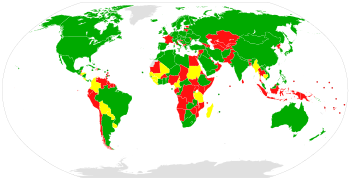This article includes a list of general references, but it lacks sufficient corresponding inline citations. (February 2011) |
| Treaty on the Prohibition of the Emplacement of Nuclear Weapons and Other Weapons of Mass Destruction on the Sea-Bed and the Ocean Floor and in the Subsoil Thereof | ||
|---|---|---|
 Ratifications and signatories of the treaty
| ||
| Signed | 11 February 1971 | |
| Effective | 18 May 1972 | |
| Condition | 22 ratifications (including depositary states) | |
| Signatories | 84 | |
| Parties | 94[1] (as of May 2014) | |
| Depositary | Governments of the United States of America, the United Kingdom of Great Britain and Northern Ireland, and the Union of Soviet Socialist Republics | |
| Languages | English, French, Russian, Spanish and Chinese | |
| Full text | ||
The Seabed Arms Control Treaty (or Seabed Treaty, formally the Treaty on the Prohibition of the Emplacement of Nuclear Weapons and Other Weapons of Mass Destruction on the Sea-Bed and the Ocean Floor and in the Subsoil thereof) is a multilateral agreement between the United States, Soviet Union (now Russia), United Kingdom, and 91 other countries[1] banning the emplacement of nuclear weapons or "weapons of mass destruction" on the ocean floor beyond a 12-mile (22.2 km) coastal zone. It allows signatories to observe all seabed "activities" of any other signatory beyond the 12-mile zone to ensure compliance.
Like the Antarctic Treaty, the Outer Space Treaty, and the Nuclear-Weapon-Free Zone treaties, the Seabed Arms Control Treaty sought to prevent the introduction of international conflict and nuclear weapons into an area hitherto free of them. Reaching agreement on the seabed, however, involved problems that were not met in framing the other two agreements.